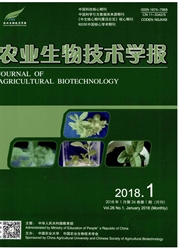

 中文摘要:
中文摘要:
Using linker peptide LP4/2A for multiple gene transformation is considered to be an effective method to stack or pyramid several traits in plants. Bacillus thuringiensis(Bt) cry gene and epsps(5-enolpyruvylshikimate-3-phosphate synthase) gene are two important genes for culturing pest-resistant and glyphosate-tolerant crops. We used linker peptide LP4/2A to connect the Bt cry1 Ah gene with the 2m G2-epsps gene and combined the wide-used man A gene as a selective marker to construct one coordinated expression vector called p2 EPUHLAGN. The expression vector was transferred into maize by Agrobacterium tumefaciens-mediated transformation, and 60 plants were obtained, 40% of which were positive transformants. Molecular detection demonstrated that the two genes in the fusion vector were expressed simultaneously and spliced correctly in translation processing; meanwhile bioassay detection proved the transgenic maize had preferable pest resistance and glyphosate tolerance. Therefore, linker peptide LP4/2A provided a simple and reliable strategy for producing gene stacking in maize and the result showed that the fusion gene transformation system of LP4/2A was feasible in monocot plants.
 英文摘要:
英文摘要:
Using linker peptide LP4/2A for multiple gene transformation is considered to be an effective method to stack or pyramid several traits in plants. Bacillus thuringiensis(Bt) cry gene and epsps(5-enolpyruvylshikimate-3-phosphate synthase) gene are two important genes for culturing pest-resistant and glyphosate-tolerant crops. We used linker peptide LP4/2A to connect the Bt cry1 Ah gene with the 2m G2-epsps gene and combined the wide-used man A gene as a selective marker to construct one coordinated expression vector called p2 EPUHLAGN. The expression vector was transferred into maize by Agrobacterium tumefaciens-mediated transformation, and 60 plants were obtained, 40% of which were positive transformants. Molecular detection demonstrated that the two genes in the fusion vector were expressed simultaneously and spliced correctly in translation processing; meanwhile bioassay detection proved the transgenic maize had preferable pest resistance and glyphosate tolerance. Therefore, linker peptide LP4/2A provided a simple and reliable strategy for producing gene stacking in maize and the result showed that the fusion gene transformation system of LP4/2A was feasible in monocot plants.
 同期刊论文项目
同期刊论文项目
 同项目期刊论文
同项目期刊论文
 期刊信息
期刊信息
